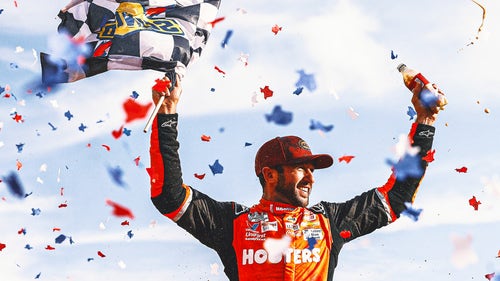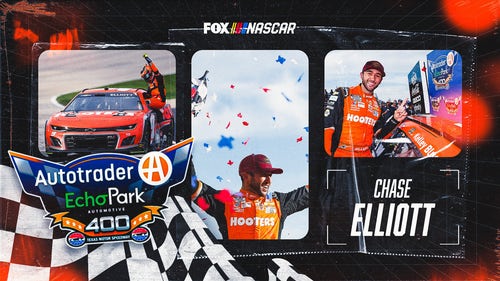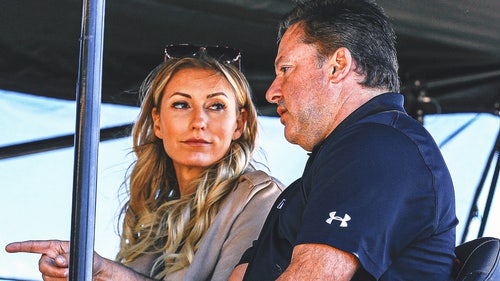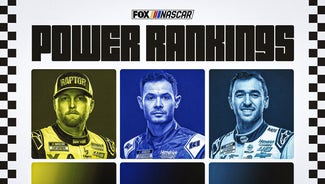
Everything you need to know about NASCAR's Next Gen car
By Bob Pockrass
FOX Sports NASCAR Writer
CHARLOTTE, N.C. – NASCAR unveiled the future on Wednesday, a seminal moment in the sport not because the cars looked different, but because of what it could mean to the competitiveness and health of the race teams.
Called the "Next Gen" car, it will be the seventh iteration of vehicle in NASCAR’s 74 years. Some drivers have tested it. Others have not, so there are plenty of unknowns.
"My time driving it from the back of the building to the center of the building, it was fantastic," quipped defending Cup champion Chase Elliott, who drove the car during the unveiling.
"That's all I have to offer on [how it drives]."
Here are the answers to the seven biggest questions.
What are the differences with this car that I can see?
The Chevrolet Camaro ZL1, Toyota Camry and Ford Mustang body styles look more like their production vehicles. The cars have hood vents, which will help with engine performance independent of aerodynamics.
But what fans might see most is what happens when a driver taps the wall. The composite body should bounce back into shape – or be easily replaced with another panel – whereas a steel body would need to be hammered back into shape and would need a much bigger section replaced if mangled.
"That’s only good for our fans because we're going to see a lot of their favorite drivers stay in events that in prior generations of our body would have probably meant the end of their day, certainly the end of their competitive day," NASCAR Senior Vice President of Racing Innovation John Probst said.
It also means fewer cut tires from a piece of sheet metal sticking out from contact slicing another competitor’s tire from slight contact.
The wheels will look different. The car has an 18-inch tire instead of a 15-inch tire (more on that in a bit).
What is the biggest difference with this car that I don’t see?
The cars have a sequential gearbox with five gears, instead of an H-pattern shifter of four gears. This car has a transaxle; the axle and gears are one unit.
The bottom of the car is sealed more than the previous car, and there is a rear diffuser that hangs from underneath the rear bumper, which hopefully will help handling in traffic and reduce the impact of dirty air.
"One of the other things that were very important to Toyota, as well as our colleagues at Ford and Chevrolet, was more technological relevancy — independent suspensions, independent rear, independent front, rack-and-pinion steering," Toyota Racing Development President David Wilson said.
"There were some low-hanging fruit that we've been waiting for years and years and years to bring to the race track."
Under the hood, the engines will be the same, but the geometry is designed to allow for a transition to hybrid technology, which could come as early as 2023.
How is the manufacturing process changing?
Teams won’t be building the cars as much as they will be assembling them. Instead of manufacturing their own chassis, body panels, spindles, etc., teams will buy them from a specified vendor.
Those who specialize in those areas for teams probably will know if they are out of a job by the end of the year, a byproduct of the idea that eventually this will lower costs for teams, as they will have fewer employees.
"The fact that there won't be manufacturers, and teams won't be manufacturers, I don't think a race fan frankly cares about that at this point," NASCAR President Steve Phelps said.
"They just want great racing, which is what they're going to see."
Teams are getting parts and pieces now and won’t be allowed to modify them. That would seem to limit the ability for mechanics and engineers to have an impact on performance.
"You can give everyone the same 9-iron, but the way you hold it, swing it, everything becomes what makes the winners and the losers when it comes to golf, right?" 2018 Cup champion Joey Logano said.
"There's even more areas here we can still race in. Believe me, there will be a lot of work to do."
Chevrolet engineer Dr. Eric Warren said the opportunities to tune the car at the track will be greater with the Next Gen.
"By having the independent rear suspension, there's a whole other degree of freedom, different things in the rear, things that you can't do now [where] we can work in the front but not the rear," Warren said.
"The Next Gen car really allows us to have both ends of the car. Also, there's some different things the way the dampers, springs and suspension attach to the car, new adjustments to how much load goes into the steering."
Looking for more NASCAR content? Sign up for the FOX Sports NASCAR Newsletter with Bob Pockrass!
Will this save teams money?
It should, but it won’t at the start. Teams will be able to have seven cars (their fleets now are seven to 15 cars). But everything they currently have will be obsolete, so the initial outlay will be significant – $2 million or more per car they have to assemble.
"The simple answer is that generally, you're having less parts and pieces you're going to be developing. Will you need to staff as many people as what you have currently?" said Denny Hamlin, who drives for Joe Gibbs Racing and co-owns 23XI Racing. "I don't know that's the case."
Hamlin said that not only cars but also tooling and other equipment will be obsolete.
"We budget on the safe side to say this car will probably be slightly more expensive for a couple years. Then we kind of see what happens after that," he said. "Crashes will play a bigger factor in your bottom line than what the current car does.
"Ultimately, when you have parts and pieces when you crash, you're manufacturing those pieces. That costs less than buying a piece off the shelf."
For small teams that purchase old equipment, there won’t be any used parts or pieces available, and that could have a bigger impact on them, as they might have to hire more people to assemble the cars. There will be plenty of people available, as fabricators and those who design parts and pieces for teams know they will be looking for work later this year or after the season. Obviously, the vendors have hired people, but the increase in workers for those companies won’t cover the downsizing of all the teams.
How will it race?
The car seems more agile, and there is hope that drivers will be able to use side forces to disrupt the car beside them in order to make a pass. The cars have a symmetrical design that they didn’t have previously.
"It's going to be more difficult to drive, especially as you get into the corners," NASCAR Executive Vice President Steve O’Donnell said. "But that's something that we're encouraged by.
"We want to put more of this back in the drivers' hands, so we'll judge that, especially on the intermediate tracks — what are drivers able to do for each and every lap, pulling up on cars and that ability to pass and not be stalled out."
The drivers who are good now are confident they will remain good, though history says a change as significant as this one will end some careers and prolong others.
"Cocky drivers believe we're better than everyone else [and] we're going to adapt quicker than everyone else," Hamlin said.
The key, Logano said, will be having an open mind.
The first test for teams likely will come in August at Daytona.
"You have to be creative. You have to be willing to look outside the box and outside of your comfort zone and not be stubborn to what you know works now," Logano said.
"There's a good chance that might not work anymore. It's going to be a very, very challenging year for every race team out there, drivers included."
Elliott is ready for it.
"You might have to reinvent yourself," he said. "There might be things and habits that I do today, right now, that work, and you can get away with that might not be an option next season.
"I think it's going to be tough, but I think the good guys will figure it out, as I think they always do and have over the years. But that's not to say it won't be difficult."
For more up-to-date news on all things NASCAR, click here to register for alerts on the FOX Sports app!
Is it safe?
William Byron wrecked a Next Gen car (not on purpose) in a test and walked away uninjured. NASCAR reportedly has done a crash test but hasn’t given much information.
"We've implemented some state-of-the-art simulation tools that have let us do things that we have not been able to do in the past, as well as a lot of subcomponent testing to where we're correlating the model from design to the testing that we had done in the lab," Probst said.
"We’ve actually ... simulated some of the bigger incidents that we've had with the current Gen-6 car on the Next-Gen car."
The driver will be moved a little closer to the center of the car. The chassis features new front and rear bumpers designed for increased safety.
Logano, whose roof was crushed last month in a flip at Talladega, also said there are more support braces in the roof.
"The first thing I noticed sitting in it, I sit lower," the 6-foot-3 Logano said. "For a driver like myself that's 6-3, getting lower in the car is important.
"I realized that in Talladega a few weeks ago, when the roof was crushed down on my head. I need to sit a little lower. That will give me a little bit more margin to start."
Where will the numbers be on the car?
NASCAR has not made a final decision on where the numbers will be located. It is working with the Race Team Alliance, a coalition of team owners, to determine whether to keep the number at the center of the door or move it more toward the rear wheel (or even the side panel).
The RTA has been gathering data to see what would work best for sponsors, as well as design.
"We did some research when we did the numbers initially at All-Star last year," Phelps said. "You know what? It's mixed. There are some fans that absolutely hate it, and there are fans that absolutely love it, so no decision as to what we're going to do on where those numbers are going to be placed.
"We're working with our teams on it. The teams are fielding a study as well right now. So that's kind of a TBD."
WHAT TO WATCH FOR
Drivers and crew chiefs often watch previous races to prepare for an upcoming race. But the 2018 Darlington race might mean more than the 2020 edition because NASCAR will use the 750 horsepower, small spoiler aerodynamic package at Darlington this year. For 2018 and 2019, Darlington was a 550-horsepower, big-spoiler track.
Kyle Larson was solid with both packages at the track. In 2018, he led 284 laps but didn’t win. Sound familiar?
Larson will be a contender, as will Denny Hamlin and Kevin Harvick, who have three wins apiece at the track, including combining to win the three races at Darlington last year.
In Xfinity and trucks, there is bonus money on the line. It is an Xfinity Dash 4 Cash race, and one driver among Noah Gragson, Jeb Burton, AJ Allmendinger and Austin Cindric will earn a $100,000 bonus. In trucks, it is a Triple Truck Challenge race, with the race winner earning a $50,000 bonus.
THINKING OUT LOUD
One of the more controversial items of the Next Gen car is the one lug nut in the center instead of five. This is one of those things that likely seems worse than it is.
Teams currently use a 15-inch steel wheel, but increasing the size of the wheels to 18 inches meant they needed to switch to aluminum, as an 18-inch steel wheel would be so heavy that it could be dangerous.
There is no way to have an aluminum wheel that can handle the loads with five smaller lug nut. So it is, unfortunately, what it is.
NASCAR and others in the industry swear that when we see the 2022 pit stop in action, it won’t look all that much different. They are probably right. The sport has probably romanticized the five lug nuts to make them seem more important than they actually are.
"The choreography is exactly the same," NASCAR President Steve Phelps said. "The number of folks over the wall, jacking up the car, taking the lug off, taking the tire off, putting the new tire on, hitting the lug. It's exactly [the same], just hitting it once instead of five times.
"I don't think the fans are going to really notice a significant difference. I really don't on that front."
Change can be hard, and many in the sport don’t want to let go of the five lug nuts. Hopefully, the pain turns out to be less in reality than it was in anticipation.
DARLINGTON PAINT
A flurry of Darlington paint schemes came out ahead of the race this weekend.
Bubba Wallace is paying tribute to Wendell Scott, the only Black driver to win a Cup race.
Corey LaJoie has an Alan Kulwicki tribute that has resonated with fans.
And of course, Richard Petty Motorsports can throw it back to one of its former paint schemes, this one used by John Andretti.
SOCIAL SPOTLIGHT
THEY SAID IT
"This is a significant moment for our sport. This car is more relevant and includes more innovation than any car in NASCAR history." – NASCAR President Steve Phelps on the Next Gen car
Bob Pockrass has spent decades covering motorsports, including the past 30 Daytona 500s. He joined FOX Sports in 2019 following stints at ESPN, Sporting News, NASCAR Scene magazine and The (Daytona Beach) News-Journal. Follow him on Twitter and Instagram @bobpockrass. Looking for more NASCAR content? Sign up for the FOX Sports NASCAR Newsletter with Bob Pockrass!









































































































































